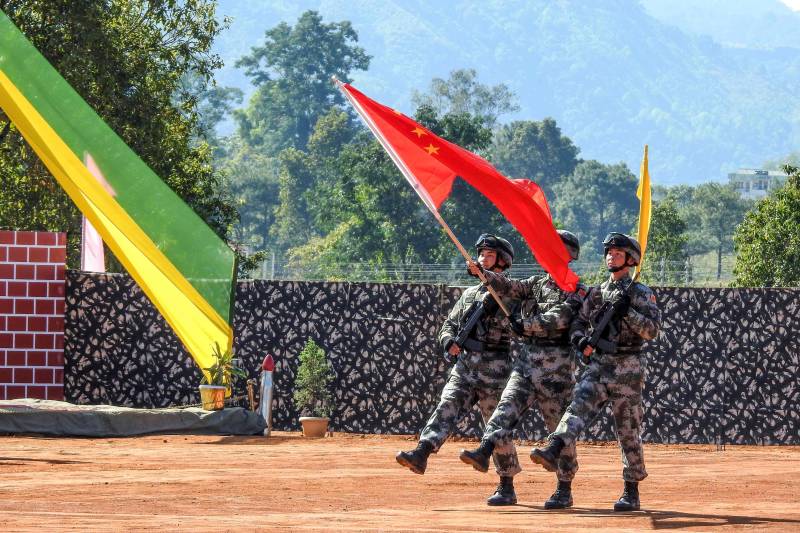‘Signs of war’ as China, India build up troops on border
Talks break down again: Beijing, Delhi bring in thousands of soldiers heavy equipment

Stay tuned with 24 News HD Android App

China and India are building troops on their mutual border as People's Liberation Army (PLA) and the Indian army had engaged in skirmishes near the border on May 5 and 9 in Ladakh.
Border negotiations to defuse the situation failed as both the sides deployed more troops and equipment on Ladakh border.
On May 5, a conflict erupted between PLA and Indian army troops gathered near the China-India border close to Pangong Tso (Pangong Lake) located in Ladakh. The two sides did not use conventional weapons, deciding instead to throw rocks at each other.
A total of 250 men joined the melee, with both sides tallying multiple injured.
On May 9, 150 Chinese and Indian soldiers engaged in another scuffle in the northeastern state of Sikkim. Although China and India later held a meeting of mid-level military officials on May 18 and 20, the two sides failed to reach an agreement regarding Pangong Tso.
The Line of Actual Control (LAC) in Ladakh is still an unresolved issue, as India has rejected China's attempts to curtail the South Asian nation's reach in the region. The lack of a willingness to compromise on both sides has led to a breakdown in negotiations.
In response to the recent scuffles, Indian army chief Manoj Mukund Naravane on May 22 went to the 14 Corps headquarters in Leh, the capital of Ladakh, to assess the situation. The Indian military subsequently ordered the reinforcement of eastern Ladakh, deploying several infantry battalions to the capital city.
According to Newstalk, China has aslo dispatched more troops to the border. Chinese military maneuvers in the region fall under the command of the PLA's Western Theater Command.
China and India share a border that stretches approximately 4,056 kilometers. Due to the lack of clear demarcation lines recognized by both sides, Chinese and Indian border patrol forces often have minor clashes. In 1962, there was a brief border war which China won.
According to latest media reports, the stand-off is reported to be across three locations in the Eastern Ladakh sector, along the Line of Actual Control (LAC).
Some defence experts have suggested that there are ‘signs of war’ as both sides have taken some unusual steps as five rounds of talks at the ground level have not been able to defuse the situation.
The Chinese military is reported to have built bunkers and moved in additional 5,000 troops. They are also said to have also used military helicopters for the aerial vigil.
To match the PLA presence along the LAC at flashpoints in Ladakh, the Indian army has also boosted its troop numbers. Further, India is also reported to be enhancing its presence in other areas as a precautionary measure.
Indian news agency ANI reported that the PLA troops have been deployed at a short notice in areas which are under the command of Indian army's 81 and 114 Brigades. These brigades have been specifically deployed to keep the Chinese off from Daulat Beg Oldie and adjoining areas.
According to Indian media reports, Delhi has also boosted troop numbers and moved in equipment at the Indian post KM120, which is normally manned by 250 troops from the army and the Indo-Tibetan Border Police.
Further, more Indian troops have been moved in into the eastern Ladakh sector using the airfield in the Daulat Beg Oldie sector, from reserves and other areas, to match the Chinese strength there.

China to deploy newly-developed reconnaissance helicopter
China's first unmanned helicopter designed for high-altitude operations recently made its maiden flight which the PLA eventually plans to deploy along its border with India.
The AR500C unmanned helicopter, developed by the state-owned Aviation Industry Corporation of China (AVIC), on Wednesday successfully made its maiden flight at an AVIC base in Poyang, East China's Jiangxi Province, in which it conducted several maneuvers including hovering, horizontal and vertical moves, China Central Television (CCTV) reported.
The unmanned helicopter is designed for reconnaissance, communication relay, electronic attack and fire strike at high altitude. The drone could help safeguard China's southwestern borders with India, analysts told state-owned Global Times on Sunday.
“The test flight of the AR500C came at a time when China-India border tensions have been flaring up, as Chinese border defense troops have bolstered border control measures and made necessary moves in response to India's recent, illegal construction of defense facilities across the border into Chinese territory in the Galwan Valley region,” the report said.
Designed to fly automomously in plateau areas, the AR500C can take off at an elevation of 5,000 meters and has a ceiling of 6,700 meters. It has an endurance of five hours, maximum speed of 170 kilometers an hour and a maximum takeoff weight of 500 kilograms. It is installed with a number of advanced flight programs for efficient and safe flights.
While its main missions are reconnaissance and communication relay, but when equipped with additional devices, it can also run electronic attack, target indication, fire strike, cargo delivery and nuclear radiation and chemical contamination reconnaissance, according to an AVIC statement.
"We utilize advanced aerodynamic design for the rotors. Since the power of the engine will drop significantly on plateaus, we use China's most advanced engine," Fang Yonghong, technology director at AVIC's helicopter branch, said on CCTV.
